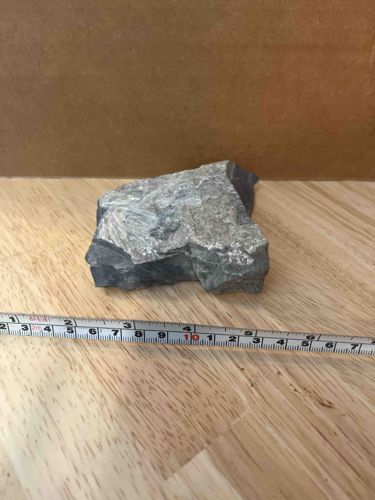
Metamorphic Rock Specimen with Silvery Mineral Inclusions
The item is an irregular, naturally fractured rock specimen, likely a metamorphic or igneous rock, given its visible texture. It appears to be primarily composed of dark grey to charcoal-colored material, with significant inclusions or veins of a lighter, silvery-grey, almost metallic-lustered mineral. These lighter mineral formations exhibit a fibrous or columnar crystal habit, arranged somewhat parallel within certain sections of the rock, suggesting a schistose or gneissic texture if metamorphic, or a coarse-grained crystalline structure if igneous. The surface of the rock is generally rough and unpolished, reflecting its natural breakage. There are no obvious signs of recent damage or repair; the edges and facets appear to be the result of natural geological processes. The overall dimensions, as indicated by the measuring tape, are approximately 10 to 12 centimeters in its longest visible dimension. Its weight is not discernible from the image but would likely be proportionate to its density. There are no discernible maker's marks, signatures, or stamps, as is typical for natural rock specimens. The rock's character suggests it could be a sample of graphite schist, biotite schist, or a similar rock type rich in mica or other platy minerals, or even a basic igneous rock with secondary mineral alteration. Its condition appears natural and weathered, typical of a specimen collected from its natural environment. The quality of the visible crystalline structures suggests a well-crystallized formation within the rock matrix.
AI-Generated Appraisal Disclaimer
Estimated Value
$20-40
Basic Information
Category
Geological Specimen
Appraised On
November 28, 2025
Estimated Value
$20-40
Item Description
The item is an irregular, naturally fractured rock specimen, likely a metamorphic or igneous rock, given its visible texture. It appears to be primarily composed of dark grey to charcoal-colored material, with significant inclusions or veins of a lighter, silvery-grey, almost metallic-lustered mineral. These lighter mineral formations exhibit a fibrous or columnar crystal habit, arranged somewhat parallel within certain sections of the rock, suggesting a schistose or gneissic texture if metamorphic, or a coarse-grained crystalline structure if igneous. The surface of the rock is generally rough and unpolished, reflecting its natural breakage. There are no obvious signs of recent damage or repair; the edges and facets appear to be the result of natural geological processes. The overall dimensions, as indicated by the measuring tape, are approximately 10 to 12 centimeters in its longest visible dimension. Its weight is not discernible from the image but would likely be proportionate to its density. There are no discernible maker's marks, signatures, or stamps, as is typical for natural rock specimens. The rock's character suggests it could be a sample of graphite schist, biotite schist, or a similar rock type rich in mica or other platy minerals, or even a basic igneous rock with secondary mineral alteration. Its condition appears natural and weathered, typical of a specimen collected from its natural environment. The quality of the visible crystalline structures suggests a well-crystallized formation within the rock matrix.
Related Tags
Get Your Items Appraised
Instant estimates of your treasures with AI-powered instant appraisals